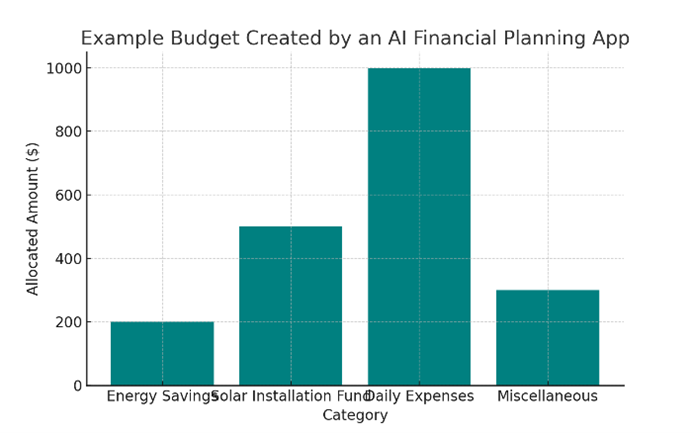How AI Can Help with Financial Planning
AI-Powered Solutions ?? Comments 03/Aug/2025 SunArtificial intelligence (AI) is revolutionizing personal financial management by offering tools that analyze spending patterns, track expenses, and provide personalized advice. When applied to energy-related financial planning, AI-powered apps can help users identify opportunities to save money, prioritize energy-efficient investments, and optimize household budgets. Below are practical steps to leverage AI for smarter financial planning.
Practical Steps
-
Use AI-Based Apps Like Cleo or Mint to Track Spending on Energy and Suggest Savings Opportunities o Cleo:
Cleo is an AI-powered budgeting app that provides insights into spending habits and financial health. Its conversational interface makes it easy to interact with and ask questions about specific expenses.
-
Energy Spending Tracking: Cleo categorizes energy-related expenses (e.g., utility bills) and highlights trends, such as seasonal increases in heating or cooling costs.
-
Savings Recommendations: Cleo offers actionable tips, such as suggesting ways to cut back on energy consumption or setting specific goals to save for energy-efficient upgrades like LED bulbs or smart thermostats.
-
Budget Management: The app helps users allocate a portion of their budget toward energy-saving investments by creating spending limits and monitoring progress. o Mint:
Mint is another popular app that uses AI to track spending, create budgets, and identify potential savings.
-
Energy Expense Analysis: Mint integrates with bank accounts and credit cards to automatically categorize utility payments, enabling users to see how much they spend on energy over time.
-
Bill Tracking: Mint alerts users when utility bills are higher than usual, helping them take corrective action or explore options for reducing costs.
-
Savings Goals: Mint allows users to set goals for energy-related projects, such as saving for solar panel installations, and tracks progress toward these goals.
-
-
Leverage AI for Personalized Budgeting and Expense Forecasting
AI-powered apps analyze historical spending data to forecast future expenses and identify potential savings. For example:
o If the app detects that energy bills tend to spike during the summer months, it might suggest budgeting extra funds for cooling costs or investing in smart home devices like programmable thermostats.
o Apps like YNAB (You Need A Budget) can help users prioritize energy-saving investments within their broader financial plan by showing how these investments align with long-term goals.
-
Use AI Tools to Identify Subscription-Based Savings Opportunities
Many AI-based financial apps, like Truebill (now Rocket Money), specialize in identifying recurring expenses. These tools can flag services or subscriptions that might be energy-related, such as appliance maintenance plans or community solar subscriptions, and suggest adjustments to reduce costs or increase value.
-
Automate Savings for Energy-Efficient Upgrades
AI tools allow users to automate savings by setting aside small amounts of money regularly. For instance:
o Apps like Digit use algorithms to analyze spending habits and automatically transfer small amounts of money into a savings account without affecting day-to-day expenses.
o These savings can be earmarked for energy-efficient upgrades, such as replacing old appliances with ENERGY STAR models or investing in renewable energy systems.
-
Track the ROI of Energy Investments Using AI Tools
Financial planning apps can help users calculate and monitor the return on investment (ROI) for energy-efficient projects. For example:
o Apps like Savology allow users to input data about their energy investments (e.g., the cost of installing solar panels) and track the financial benefits over time, such as lower energy bills or tax incentives.
o ROI tracking ensures that users remain informed about the financial performance of their energy-saving decisions and can adjust their strategies accordingly.
-
Monitor Utility Rate Trends and Budget Accordingly
Some AI-powered apps incorporate data on utility rates and tariffs, helping users anticipate changes in energy costs and adjust their budgets. For example:
o If rates are expected to increase, the app might recommend increasing savings for future bills or exploring alternative energy sources like community solar programs.
-
Integrate AI Financial Planning with Green Financing Options
AI tools can help users evaluate green financing options, such as eco-loans or tax credits, by incorporating these into their overall financial plan. For instance:
o An app might recommend applying for a specific financing program to fund an energy-efficient HVAC system and show how the monthly loan payments would fit into the user’s budget while accounting for projected energy savings.
Key Benefits of Using AI for Financial Planning
-
Enhanced Awareness:
AI-powered tools provide real-time insights into energy spending, making it easier to understand where money is going and identify opportunities for improvement.
-
Personalized Recommendations:
AI tools offer tailored advice based on individual spending patterns and financial goals, ensuring that energy-saving strategies are practical and effective.
-
Convenience:
Automating savings, tracking expenses, and setting goals require minimal effort, freeing users to focus on other priorities.
-
Cost Savings:
By identifying inefficiencies and offering actionable advice, AI tools help users reduce energy expenses and allocate funds more effectively.
-
Support for Long-Term Goals:
Whether saving for renewable energy installations, energy-efficient appliances, or home upgrades, AI tools help users stay on track and achieve their goals.
By leveraging AI-powered financial planning tools like Cleo, Mint, and others, users can gain control over their energy-related expenses, identify cost-saving opportunities, and build a more sustainable financial future.
Example: An AI app helped a user create a budget for switching to solar energy within two years.
